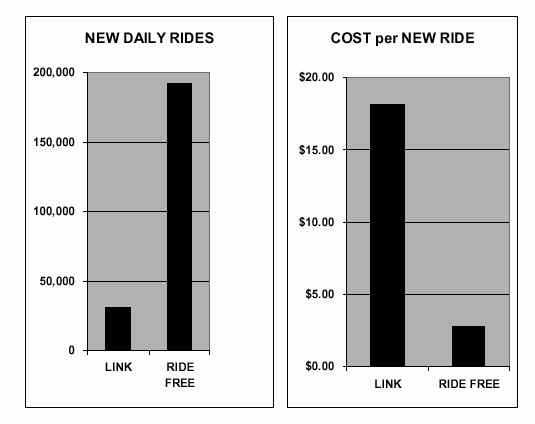![]()
![]()
![]()
![]()
![]()

Source: Ride Free Express Draft Plan document, January 2001, page 11
Excerpt from Ride Free Express Plan: Traditional versus Market-driven Approach
Traditionally, fixed-route transit system plans identify a corridor with high travel volumes. Then a route is devised that serves a large number of destinations along the corridor. The problem with this approach in urban areas is that such corridors are usually already well served by buses. As a result, if a rail line is built, most of the passengers are pre-existing bus riders who are merely shifted to rail at very great taxpayer expense. When considering this reality, it isn’t surprising that only thirty percent of trips on Link are forecast to be made by new riders.
The Ride Free Express market-driven approach responds only to actual demand. It provides the means and the incentives to attract new riders where transit service has been noncompetitive. For bus riders, the means consist of more frequent service on high demand routes, new traffic signals and HOV improvements to speed service. For commuters to suburban employment destinations, the means consist of 4,000 vans, which respond only to actual demand. The market determines the routes and destinations. For all commuters, the fundamental incentive is free fare.
Ride Free Express
does not attempt to predict new routes and bus service levels. As fares are eliminated, ridership counts on the buses will dictate where more service is needed. Vanpool groups will figure out the best route and schedule for their members. In this way, travel demand can be translated into 4,000 separate routes, each tailored to the needs of a particular group of commuters. In this way, Ride Free Express has the flexibility to respond to changes in this rapidly growing region.
"Trains have great intuitive and romantic appeal. It is easy to get caught up in the dream, but elected representatives owe us more than a dream. They owe us prudent and thoughtful use of our money. If the right investment criteria are new riders, cost and risk, this is not a close call: Link should not be built." Chuck Collins, Seattle Post-Intelligencer, November 1, 2000 |
![]()
Return to the Public Interest Transportation Forum home page.
![]()
Page Entered: Early 2001